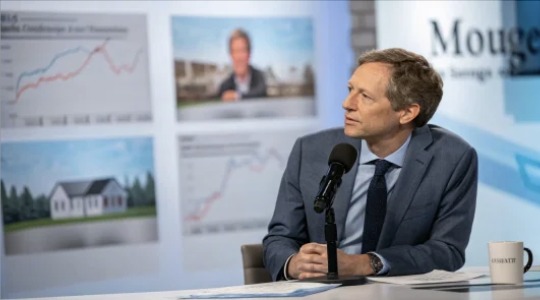Table of Contents
ToggleUnderstanding the Retail Sales Report
On Tuesday, there was a focus on what was colloquially known as the “drunken sailor” retail sales report. This report is essential because consumers are the primary driving force behind our economy, accounting for nearly 70% of economic activity. In my view, retail sales serve as an early barometer revealing how consumers are faring amid uncertainties linked to tariffs and global trade disputes.
The report expected a decline of approximately 0.6%. This drop is tied to the ongoing uncertainty over tariffs. Although a small percentage might seem negligible, even minor changes in consumer spending can have large ripple effects across the economic system.
The data highlights a few points:
- Consumer spending makes a substantial contribution to our economy.
- The report reflects potential hesitancy among consumers due to trade policy uncertainties.
- A slight decline such as 0.6% could signal deeper issues if it continues over several periods.
This decline makes investors cautious. It serves as a reminder that even seemingly modest data points may indicate larger economic challenges. While some view this dip as temporary, others are more cautious and see it as a sign to prepare for less robust spending in the near term.
View this post on Instagram
The Federal Reserve Rate Decision
Wednesday brought another noteworthy event with the Federal Reserve rate decision. Markets widely anticipated that there would be no interest rate cuts. There is an overwhelming probability—approximately 99.9%—that rates would remain unchanged. Nevertheless, a slight possibility exists for a rate hike.
This decision has important ramifications. Interest rates affect the cost of borrowing, corporate profits, and ultimately, market behavior. Through my years of experience, I have learned that even a small shift in rates can influence investment strategies and everyday financial decisions.
A few key points stand out regarding the rate decision:
- Market expectations leaned towards maintaining current rates.
- The possibility of a rate hike creates uncertainty around future economic conditions.
- Investors are closely watching Fed Chair Powell’s press conference to gain a better understanding of future policy directions.
A close observation of Powell’s remarks is essential. His comments carry significant weight in shaping market sentiment, and any hint at future adjustments can lead to tangible market reactions. It is prudent to watch for nuances in his statements, as these might offer further clarity on upcoming policies.
Analyzing the Leading Economic Indicators Report
Finally, the week concluded with the release of the leading economic indicators report. This report is designed to forecast economic trends and often serves as a harbinger of future growth or contraction. The expected contraction of approximately 0.6% adds another layer of uncertainty.
This report provides a glimpse into what may lie ahead. A contraction indicates that the economy may face challenges, such as a slowdown in business activities and potentially fewer hiring opportunities. For investors and planners alike, this is a signal to remain alert and ready to adjust strategies where needed.
Critical aspects from the report include:
- The indicators suggest a modest contraction in economic activity.
- Such contraction may prompt businesses and investors to reassess their short-term plans.
- Combined with earlier data, this contraction deepens the sense of uncertainty within the market.
Reports like these are essential for providing a forward-looking perspective. They help us gauge the overall pace of economic activity and prepare for any adjustments that may arise. As economic indicators weaken, there is a consensus that caution is advisable when planning for the future.
Implications for Investment Strategies
Combining the three events, it becomes apparent that the market is facing a mix of predictable trends and unexpected outcomes. The slight decline in retail sales, the unwavering stance on interest rates, and the contraction indicated by leading indicators suggest that careful financial planning is crucial.
From my experience as a financial planner, these events reinforce a few investment principles:
- Diversify investments to mitigate risks amid economic uncertainties.
- Maintain flexibility in portfolio allocations to anticipate potential rate changes.
- Monitor economic data frequently to adjust strategies promptly.
In periods of uncertainty, a disciplined approach to investing is beneficial. It is essential to adopt a balanced strategy that considers both short-term developments and long-term objectives. Investors need to remain informed and adapt to shifts in market conditions.
Reflections on Market Uncertainty
As a professional in the financial industry, I have witnessed numerous cycles of optimism and caution. Recently, the combination of these three events—declining retail sales, a cautious Fed decision, and a contraction in economic indicators—has added a layer of complexity to investment decisions.
One of the challenges we face is separating the signal from the noise. On some days, market reports may seem alarming. However, by carefully analyzing the data, one can identify underlying trends rather than reacting hastily to short-term signals.
The data from these reports serves as a compass in uncertain times.” – Taylor Sohns
This sentiment resonates with many investors. Instead of allowing anxiety to drive decision-making, it is more constructive to consider how each piece of data fits into the broader economic picture. Analyzing key points helps distinguish between temporary fluctuations and sustained trends.
My Approach to Tough Market Conditions
Experience has taught me that market conditions can be challenging. I advocate for a calm and systematic approach to evaluating trends. Recognizing that consumer spending, monetary policy, and economic forecasts each offer valuable information is essential for a balanced view.
During challenging times, I continue to emphasize the importance of:
- Regular review of financial goals
- Continuous monitoring of market developments
- Engagement with credible sources to base decisions on facts
This strategy not only helps in managing current portfolios but also provides a framework to withstand market turbulence. Markets may face uncertainty, yet informed decisions can reduce the impact of volatility over time.
Translating Data Into Decisions
Each market event of this week has implications that extend beyond the numbers. Data should be viewed as guidance rather than a verdict. For instance, while the retail sales report signals caution, its implications require a broader financial context. The same holds true with the Fed rate decision and the economic indicators report.
Decisions based on this analysis involve several factors:
- If retail sales continue to decline, a more conservative approach might be warranted in consumer-focused sectors.
- With clear signals from the Federal Reserve on interest rates, borrowing costs, and investment income projections need adjustments.
- The contraction in economic indicators advises caution in markets that rely heavily on growth.
These factors underscore the need to balance immediate market signals with longer-term investment plans. Even slight shifts in one area may require rebalancing portfolios and readjusting risk appetite. A prudent approach focuses on resilience, ensuring that portfolios can weather market swings while remaining aligned with long-term goals.
The Broader Economic Picture
It is essential to step back and consider the broader economic context. While each report comes with statistical data, the interactions among these reports shape market sentiment. I have noticed that periods of uncertainty sometimes encourage a more conservative approach among both investors and planners.
This week’s developments remind us that multiple interconnected factors influence markets. The interplay between consumer behavior, interest rates, and general economic trends creates a dynamic environment that demands continuous attention.
One aspect that remains constant is the importance of being prepared. A robust financial plan allows one to navigate through ups and downs without losing sight of underlying goals.
Moreover, I find that regular updates and professional insights help clients and fellow investors understand that fluctuations are a regular part of the economic cycle. Even as market conditions shift, preparedness and a measured perspective remain key assets.
Conclusion and Key Takeaways
Reflecting on the week’s major events reveals several important conclusions. First, consumer spending remains a vital indicator. A small drop, as seen in the retail sales report, has broad implications. Second, the Federal Reserve’s decision on interest rates shows a cautious approach toward monetary policy. Even though a rate cut is nearly out of the question, the possibility of a slight hike remains on the radar. Third, the leading economic indicators signal a contraction that warrants careful monitoring.
In summary, these events serve as a reminder that detailed analysis and adherence to a disciplined investment strategy are necessary. They encourage ongoing portfolio reviews and emphasize the importance of flexibility. The blend of economic signals calls for readiness to adjust financial plans when market conditions evolve.
For investors and planners alike, I recommend maintaining a balanced approach to investing. Continually reviewing financial goals and staying updated with credible data is essential. While uncertainties exist, a sound strategy built on solid analysis can provide much-needed stability.
Ultimately, steady vigilance and disciplined planning are the best ways to navigate market ebbs and flows. I hope this review provides clarity and perspective to those who closely follow market trends and make decisions accordingly.
Frequently Asked Questions
Q: What does the retail sales drop indicate?
It reflects reduced consumer spending, which can indicate broader economic challenges if the trend persists over time.
Q: How should investors view the Federal Reserve’s decision?
Investors should understand that maintaining rates limits borrowing costs. Even a small chance of a rate hike calls for preparing flexible investment strategies.
Q: Why are leading economic indicators important?
They offer a forward-looking measure of economic activity. A contraction in these indicators signals caution and encourages a review of financial plans.

















